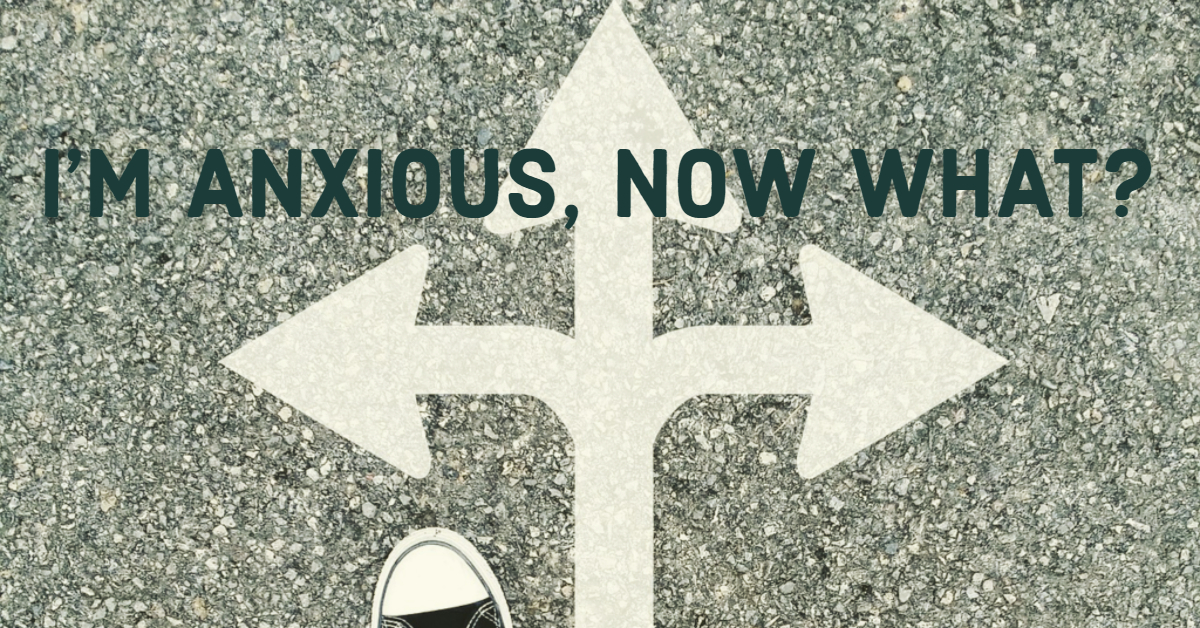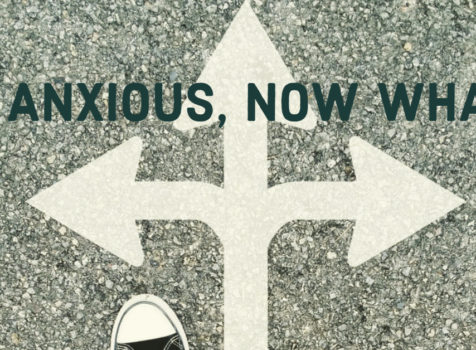This is the final post in a three part series on counseling for anxiety. The first two posts are important for understanding the function of anxiety and developing a new mindset about how we relate to our anxious experiences. This article is about what steps you can take when you find yourself confronting anxiety. You can read the previous articles in this series here: First Article, Second Article.
Creating a New Attitude about Anxiety
The most important step you can take to overcoming your anxiety is to develop a new attitude about anxiety. I challenge you to be willing to confront your anxiety head on. If you are struggling with anxiety, you are probably avoiding it at all costs. A new attitude involves physically approaching potential triggers, and more importantly, approaching them with a mindset of wanting to practice new skills. You have to find a way to make sense of the logic that allowing your mind to sit with anxiety without engaging avoidance allows you to retrain your brain.
Set Realistic Goals
It’s important that you set realistic and achievable goals for yourself. Your overarching goal should not be to get rid of your anxiety. You need to be anxious sometimes. Animals without anxiety are dead animals. Another reason anxiety abstinence is an unhealthy goal is because you have no control over whether or not your body produces anxiety. We can only control our behavioral response to anxiety.
My hope for you is that you are able to learn how to invest in the life you want and value whether you are feeling anxious or not. The ability to live the life you choose even in the midst of anxiety is a more freeing goal than waiting until anxiety is gone to live the life you want.That being said, if you can adopt the goal of learning to be a little better at responding to anxiety each day, I firmly believe that you will experience less intense anxiety.
- Unhelpful goal: “I want to stop feeling anxious” (1. That’s dangerous and 2. You can’t control it)
- More helpful: “I want to stop responding to my irrational anxiety and choose the life I value
Create A Reason Why
When you start applying your new attitude, anxiety will pull out all the stops to warn you. After all, it’s job is to keep you safe and it will panic when you begin ignoring it’s warning signals. When anxiety intensifies you will need to call upon the reasons why you are adopting this new attitude.
To create your ‘why’, think about the costs of your current relationship with anxiety. How does it affect you? Your work? Your family? How much time do you spend with it? What does it keep you from doing? What is at risk if you continue to live with anxiety as you currently are? You will need to call upon these answers when anxiety pulls out the big guns.
Treat Emotions as Cues
Take some time to think about the irrational ways anxiety likes to mess with you. Knowing the importance of adopting a new strategy towards anxiety, go ahead and develop a game plan for how you will respond to irrational anxiety (junk mail/Facebook spam).
Don’t try to do this in the moment, because you will feel unconfident and overwhelmed. When you have a plan of what you will say to yourself and how you will respond, allow the feeling of anxiety to cue this response. Develop the formula of, “If I feel ______, then I do ______”.
For example, sometimes I go for runs along the Tweetsie Trail. I know going into these runs that I will hit a point where my brain begins to throw me signals of discomfort. My legs will ache and I’ll feel out of breath. My mind will create countless reasons why I should stop. Suddenly I find myself torn between two brains. The emotional brain who wants to take a break and the rational brain who encourages me to keep going. Before the run, I have already decided how I want to deal with this scenario. I remind myself of why I am running. I remind myself of all the times I have continued to run in the past. I give myself a pep talk. All these tools I have stored in my mental tool chest. Now when the feeling of wanting to stop occurs, I know to open up this tool box and put them to use. I don’t stop to re-evaluate the accuracy of the feeling or to develop a game plan on site. I have already created a blueprint for my response.
Talk To Yourself
We all maintain a private dialogue in our minds. The ability for us to narrate our own thinking can be extremely beneficial for regulating emotions. Use your brain’s ability to hold multiple perspectives for good. Learn to name your anxiety, describe what it feels like, thank it for protecting you, and then explain why you are not going to follow it’s advice.
For example, “Wow, anxiety, thank you for warning me about the all the ways my life could go wrong today but I’ve already decided that I don’t need to respond to these threats. You’re welcome to hang out if you want, but I’m going to go back to living my life”.
Your Anxiety is a Headache
Have you ever awoken in the morning with a mild headache? I’m sure that you have.Did you spend the rest of the day trying to get rid of this headache or did you say to yourself, “well this is uncomfortable and I wish my head didn’t hurt. I will take some medicine and then continue my day”?
When anxiety is asking us to respond to irrational fears, we need to approach it the same way we approach uncomfortable physical feelings. Yes they are annoying, but we don’t need to do much about them. It’s okay to notice the uncomfortable feeling and then turn out attention towards our goals for the day. We do this all the time with our physical feelings. Now I’m asking you to adopt the same strategy for your emotional experiences.
What If I Can’t Tell Real Anxiety from Irrational Anxiety?
Put Thoughts On Trial – Imagine you are tasked with being prosecutor, defendant, and jury all at once to argue the thought. Let your rational brain do what it does best by examining the evidence, deciding a verdict, and declaring a sentence.
Bet Your Life Savings – Consider the thought that is creating anxiety for you. Now imagine you have to put a bet of your entire life savings and future earnings on an outcome to this thought. You can’t know for certain you will be right, but you have to make a choice one way or another. Which do you choose?
Examine the Evidence: Ask yourself if you are considering all the evidence available. Are there things that you are skipping or looking past? Do the worry represent something that is likely? Is the worry something that you have control over? Are there arguments you might be able to make against the thought?
But it Still Feels Real
I’m going to tell you something frustrating. You may do all these mental gymnastic tricks and the feeling will still be there. You can decide that the fear is irrational and does not require a response. You can even be entirely certain of that, and it may still feel very real.
This is because the emotional response is the same electrical pulses in your brain and same cortisol in your body. Whether anxiety is rational or irrational the amygdala triggers the same physiological response. That part is out of our control. This is where it’s important to remind ourselves the goal is not to make the feeling go away, but instead to learn that the feeling does not require a response. By doing this with a lean-in, challenger attitude, we eventually train our brain to stop signaling as strong of a threat.
The Miracle Question and Your Valued Life
Ask yourself The Miracle Question: if I didn’t have my overwhelming anxiety, how would my life be different? Would I carry myself differently? Would I interact with others differently? Would I dress the same? Would I be doing more or less of some things? What would people notice about me? What would I get excited about? What words would I use to describe myself?
The answer to these questions can help reveal your valued life. By learning to hear your anxiety and being willing to tolerate its message, you can choose to spend your energy towards living that valued life. Setting your mind towards creating a valued life in the face of anxiety will prove more fulfilling than attempting to avoid something you cannot control. Anxiety will still try to interfere at times, but its message will seem much less important.
Putting it all together and Your Valued Life
So the entire process looks something like this:
Experience an anxiety trigger – notice the feeling – name the feeling – evaluate its accuracy – tell yourself why you are going to ignore it – point your behavior in the direction you prefer.
What you are doing is teaching your brain that the feeling of anxiety is sometimes irrelevant. That it does not always require a response. It does not always represent real danger. To do this, you will learn to stop responding with safety behaviors or mental panic which only serve to validate your amygdala and encourage more anxiety.
Your Next step
If you continue to struggle with anxiety and are ready to make a change in your life, I encourage you to reach out and schedule an appointment. You can contact me through the button below or you can call me at 423-491-5822.
Request an AppointmentHelpful Resources
Click HERE to visit my page on anxiety resources where you can learn more about anxiety and effective treatment.
Click HERE to go back to my blog homepage
Meet the author
Ben Taylor is a counselor in Johnson City and Kingsport, TN. He provides counseling for adolescents, adults, and couples. He specializes in treating Anxiety related concerns including OCD, Panic, Social Anxiety, and PTSD. He also works closely with couples seeking to increase effective communication, navigate infidelity, and rekindle past romances.
Ben sets himself apart of other counselors by making therapy a more personal experience. He works well with clients new to therapy and challenges the notion of what it means to be in therapy. Ben strives to make therapy a more normal experience by developing a sincere interest in his clients, balancing humor and honesty, and offering a non-judgmental space for creating your ideal self. He takes pride in creating a counseling experience that is genuine enough for laughter and tears but honest enough to talk about what needs to be changed.

